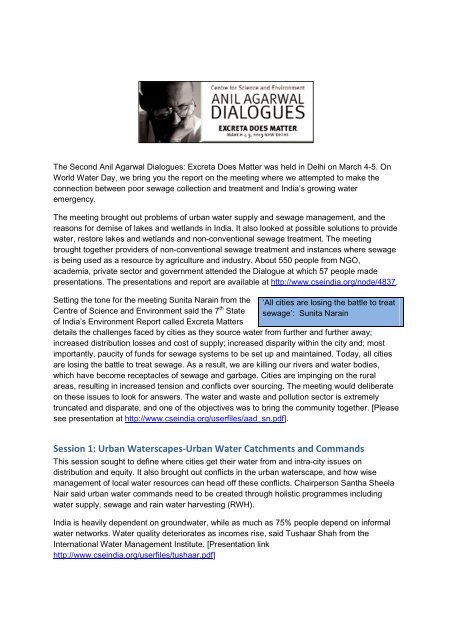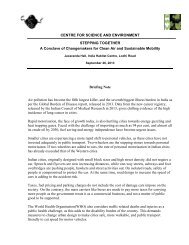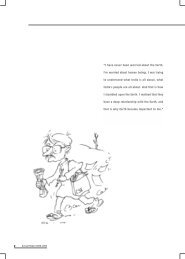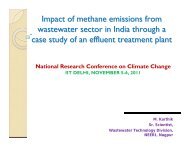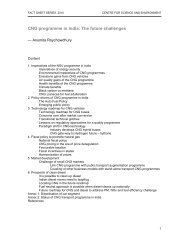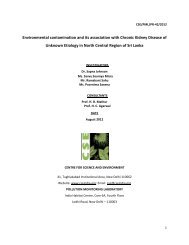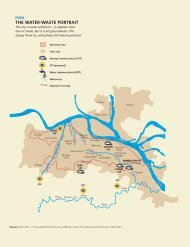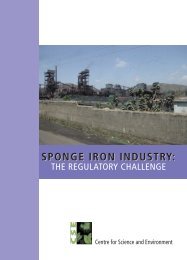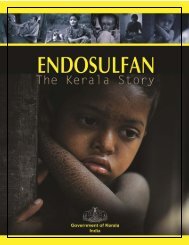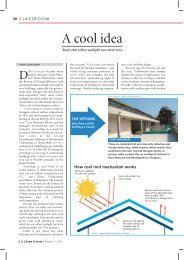the full report. - Centre for Science and Environment
the full report. - Centre for Science and Environment
the full report. - Centre for Science and Environment
You also want an ePaper? Increase the reach of your titles
YUMPU automatically turns print PDFs into web optimized ePapers that Google loves.
The Second Anil Agarwal Dialogues: Excreta Does Matter was held in Delhi on March 4-5. On<br />
World Water Day, we bring you <strong>the</strong> <strong>report</strong> on <strong>the</strong> meeting where we attempted to make <strong>the</strong><br />
connection between poor sewage collection <strong>and</strong> treatment <strong>and</strong> India’s growing water<br />
emergency.<br />
The meeting brought out problems of urban water supply <strong>and</strong> sewage management, <strong>and</strong> <strong>the</strong><br />
reasons <strong>for</strong> demise of lakes <strong>and</strong> wetl<strong>and</strong>s in India. It also looked at possible solutions to provide<br />
water, restore lakes <strong>and</strong> wetl<strong>and</strong>s <strong>and</strong> non-conventional sewage treatment. The meeting<br />
brought toge<strong>the</strong>r providers of non-conventional sewage treatment <strong>and</strong> instances where sewage<br />
is being used as a resource by agriculture <strong>and</strong> industry. About 550 people from NGO,<br />
academia, private sector <strong>and</strong> government attended <strong>the</strong> Dialogue at which 57 people made<br />
presentations. The presentations <strong>and</strong> <strong>report</strong> are available at http://www.cseindia.org/node/4837.<br />
Setting <strong>the</strong> tone <strong>for</strong> <strong>the</strong> meeting Sunita Narain from <strong>the</strong><br />
<strong>Centre</strong> of <strong>Science</strong> <strong>and</strong> <strong>Environment</strong> said <strong>the</strong> 7 th State<br />
of India’s <strong>Environment</strong> Report called Excreta Matters<br />
‘All cities are losing <strong>the</strong> battle to treat<br />
sewage’: Sunita Narain<br />
details <strong>the</strong> challenges faced by cities as <strong>the</strong>y source water from fur<strong>the</strong>r <strong>and</strong> fur<strong>the</strong>r away;<br />
increased distribution losses <strong>and</strong> cost of supply; increased disparity within <strong>the</strong> city <strong>and</strong>; most<br />
importantly, paucity of funds <strong>for</strong> sewage systems to be set up <strong>and</strong> maintained. Today, all cities<br />
are losing <strong>the</strong> battle to treat sewage. As a result, we are killing our rivers <strong>and</strong> water bodies,<br />
which have become receptacles of sewage <strong>and</strong> garbage. Cities are impinging on <strong>the</strong> rural<br />
areas, resulting in increased tension <strong>and</strong> conflicts over sourcing. The meeting would deliberate<br />
on <strong>the</strong>se issues to look <strong>for</strong> answers. The water <strong>and</strong> waste <strong>and</strong> pollution sector is extremely<br />
truncated <strong>and</strong> disparate, <strong>and</strong> one of <strong>the</strong> objectives was to bring <strong>the</strong> community toge<strong>the</strong>r. [Please<br />
see presentation at http://www.cseindia.org/userfiles/aad_sn.pdf].<br />
Session 1: Urban Waterscapes-Urban Water Catchments <strong>and</strong> Comm<strong>and</strong>s<br />
This session sought to define where cities get <strong>the</strong>ir water from <strong>and</strong> intra-city issues on<br />
distribution <strong>and</strong> equity. It also brought out conflicts in <strong>the</strong> urban waterscape, <strong>and</strong> how wise<br />
management of local water resources can head off <strong>the</strong>se conflicts. Chairperson Santha Sheela<br />
Nair said urban water comm<strong>and</strong>s need to be created through holistic programmes including<br />
water supply, sewage <strong>and</strong> rain water harvesting (RWH).<br />
India is heavily dependent on groundwater, while as much as 75% people depend on in<strong>for</strong>mal<br />
water networks. Water quality deteriorates as incomes rise, said Tushaar Shah from <strong>the</strong><br />
International Water Management Institute. [Presentation link<br />
http://www.cseindia.org/userfiles/tushaar.pdf]
A host of new cities are coming up across <strong>the</strong> country. Gurgaon is a glittering example of urban<br />
planning run amok. The Delhi-Mumbai Industrial Corridor is ano<strong>the</strong>r mega-infrastructure project<br />
that envisages ‘development’ of many more. Amitabh Kant, <strong>the</strong> project’s chief executive officer,<br />
underlined <strong>the</strong> importance of planning to manage <strong>the</strong>ir waste water. The Corridor project plans<br />
‘The Delhi-Mumbai Industrial Corridor<br />
could be an opportunity to create<br />
model cities’: Amitabh Kant<br />
to integrate diversified water sources, enhance aquifer<br />
storage <strong>and</strong> identify <strong>and</strong> restore existing water bodies.<br />
This could be an opportunity to create model cities.<br />
[Presentation link:<br />
http://www.cseindia.org/userfiles/DMIC-amitabh.pdf]<br />
India’s rapid urbanization <strong>and</strong> industrialization have created new flashpoints, said K J Joy from<br />
<strong>the</strong> Society <strong>for</strong> Promoting Participative Ecosystem Management. These concern sourcing of<br />
water, allocation, access, pollution, water sector ‘re<strong>for</strong>ms’ <strong>and</strong> institutional issues. They can be<br />
resolved by rebalancing dem<strong>and</strong>, addressing equity concerns, sensible allocations <strong>and</strong><br />
safeguarding rural livelihoods. [Presentation link:<br />
http://www.cseindia.org/userfiles/k%20j%20joy.pdf].<br />
Intra-city conflicts are due to <strong>the</strong> institutional <strong>and</strong> organizational issues that prevent access to<br />
water. Women <strong>and</strong> children are especially vulnerable to <strong>the</strong>se restrictions, said Marie-Helene<br />
Zerah from <strong>the</strong> Institut de Recherche Pour Le Developpement. This can be addressed through<br />
decentralization <strong>and</strong> participatory policy <strong>for</strong>mulation ra<strong>the</strong>r than capacity building. [Presentation<br />
link: http://www.cseindia.org/userfiles/marie_20130319.pdf].<br />
Cities ignore <strong>the</strong> environment but emphasize <strong>the</strong> creation of physical <strong>and</strong> economic<br />
infrastructure, said S Janakarajan, of <strong>the</strong> Madras Institute of Development Studies. In Chennai,<br />
<strong>the</strong>re are 1,400 tanks that if properly restored integrated can store a substantial quantity of<br />
water, help <strong>the</strong> city cope with floods <strong>and</strong> ameliorate its groundwater crisis. [Presentation link:<br />
http://www.cseindia.org/userfiles/Janakarajan.pdf]<br />
Chennai, Santha Nair said, is of <strong>the</strong> first cities that made rooftop RWH m<strong>and</strong>atory, <strong>and</strong> 90%<br />
households have <strong>the</strong>se systems. On pricing, she said <strong>the</strong> aim should be resource conservation<br />
ra<strong>the</strong>r than cost recovery.<br />
Session 2, Sponging off Urban Lakes<br />
Lakes are critical to a city’s survival as <strong>the</strong>y store excess water from heavy rainfall events, help<br />
retain groundwater levels, are biodiversity hotspots <strong>and</strong> moderate <strong>the</strong> climate. However, <strong>the</strong>y<br />
have lost <strong>the</strong>ir importance as cities have started sourcing water from fur<strong>the</strong>r <strong>and</strong> fur<strong>the</strong>r away<br />
<strong>and</strong> high l<strong>and</strong> prices have encouraged city ‘development’ agencies to value <strong>the</strong> l<strong>and</strong> instead of<br />
<strong>the</strong> water. These were <strong>the</strong> main points from this session.<br />
Anjal Prakash of SACIWaters said ano<strong>the</strong>r reason <strong>for</strong> <strong>the</strong> decline of urban lakes was <strong>the</strong> tanker<br />
mafia. In Hyderabad, about 3245 hectares of lakes have disappeared between 2001 <strong>and</strong> 2012<br />
because of <strong>the</strong>se reasons. The city had 684 lakes interconnected in cascading system but only<br />
a few survive, <strong>and</strong> even <strong>the</strong>se are under threat. However, with a judicious blend of technology
<strong>and</strong> legal action, <strong>the</strong>y can be saved. [Presentation link:<br />
http://www.cseindia.org/userfiles/anjal_prakash_hydlakes.pdf]<br />
In Bangalore, <strong>the</strong> situation is as bad, said Bhargavi Rao of <strong>Environment</strong> Support Group. It was<br />
entirely dependent on its lakes <strong>and</strong> <strong>the</strong> Arkavathy river <strong>for</strong> water till a few decades ago, but now<br />
draws water from <strong>the</strong> Kaveri river that is 100 km away <strong>and</strong> 500 m below <strong>the</strong> city level. The city<br />
‘development’ authorities are responsible <strong>for</strong> much of <strong>the</strong> lakes’ demise. Concretization is<br />
ano<strong>the</strong>r cause <strong>for</strong> <strong>the</strong> city’s water emergency as it has reduced groundwater recharge. The<br />
city’s lake development authority has h<strong>and</strong>ed over three lakes to private companies <strong>for</strong><br />
maintenance, affecting traditional livelihoods. The city depends heavily on groundwater,<br />
extracting three times <strong>the</strong> recharge. Even though rainwater is m<strong>and</strong>ated, just 44,700 houses out<br />
of about a million in <strong>the</strong> city have any sort of rainwater harvesting system. [Presentation link:<br />
http://www.cseindia.org/userfiles/Bangalores_Lakes_Bhargavi.pdf]<br />
Srinagar has dealt with <strong>the</strong> problem of Dal Lake’s pollution on several fronts, said Irfan Yasin of<br />
<strong>the</strong> Lakes <strong>and</strong> Waterways Development Authority. It was receiving silt <strong>and</strong> sewage from houses<br />
<strong>and</strong> boats on <strong>the</strong> periphery was polluting it. The Authority is setting up a sewage treatment plant<br />
to reduce pollution. It has divided <strong>the</strong> catchment into 12 micro-watersheds <strong>and</strong> planted trees to<br />
reduce siltation. Buffers have been set up between <strong>the</strong> catchment <strong>and</strong> <strong>the</strong> lake to clean <strong>the</strong><br />
water runoff be<strong>for</strong>e it enters <strong>the</strong> lake, <strong>and</strong> 60,000 people living around <strong>the</strong> lake have been<br />
resettled.<br />
The Vembanad Lake in Kerala is a Ramsar site but has shrunk to a third of its original area over<br />
<strong>the</strong> past century. N C Narayanan from <strong>the</strong> <strong>Centre</strong> <strong>for</strong> Technology Alternatives <strong>for</strong> Rural Areas at<br />
IIT Bombay said bunds built to keep out sea water <strong>and</strong> improve paddy cultivation around <strong>the</strong><br />
lake have altered its ecology <strong>and</strong> polluted <strong>the</strong> backwaters connected to <strong>the</strong> lake. Tourism has<br />
also affected <strong>the</strong> lake, <strong>and</strong> an estimated 2,500 million litres a day (MLD) of sewage enters <strong>the</strong><br />
lake. To tackle this, panchayats need more regulatory powers, <strong>and</strong> a campaign involving NGOs,<br />
teachers <strong>and</strong> students is needed. [Presentation link:<br />
http://www.cseindia.org/userfiles/nc_narayanan.pdf]<br />
Mansagar Lake in Jaipur is one model of restoration of an urban water body by a private<br />
company. Rajeev Lunkad, a Delhi-based architect<br />
<strong>and</strong> urban planner said it was a joint ef<strong>for</strong>t between<br />
<strong>the</strong> Jaipur municipality, <strong>the</strong> Jaipur Development<br />
Authority, Ministry of <strong>Environment</strong> <strong>and</strong> Forests <strong>and</strong><br />
<strong>the</strong> pollution control board. Through this approach,<br />
‘Mansagar Lake in Jaipur is one model<br />
of restoration of an urban water body by<br />
a private company’: Rajeev Lunkad<br />
<strong>the</strong> sewage has been diverted to a constructed wetl<strong>and</strong> with a 7 MLD capacity be<strong>for</strong>e it enters<br />
<strong>the</strong> lake. The depth has been increased to 2.5 m. Using a novel approach, storm water is being<br />
treated in a sedimentation basin, location in <strong>the</strong> lake itself. [Presentation link:<br />
http://www.cseindia.org/userfiles/mansagar_lake.pdf]<br />
The session chairperson M Ramach<strong>and</strong>ran said a listing of water bodies is a prerequisite to any<br />
revival <strong>and</strong> restoration work. It should be monitored by prominent citizens. A model law drafted<br />
with inputs from <strong>the</strong> public is ano<strong>the</strong>r necessity. Urban planning has to incorporate protection of<br />
water bodies.
Session 3, Ground Water – What Lies Beneath<br />
More than half of India’s urban population depends on groundwater <strong>for</strong> its needs. However, this<br />
critical resource is neglected <strong>and</strong> abused. Its use is never properly accounted <strong>for</strong> by individual<br />
users <strong>and</strong> water utilities, <strong>and</strong> <strong>the</strong>re<strong>for</strong>e, it is not protected or used sustainably. The session<br />
considered ways to estimate <strong>the</strong> role of groundwater in urban water budgets, improving data<br />
collection, ways to use it more sustainably <strong>and</strong> how to make <strong>the</strong> regime governing groundwater<br />
more effective.<br />
At <strong>the</strong> macro level, 1.5 billion people <strong>and</strong> 48% of Indians live off groundwater. The main<br />
reasons are <strong>the</strong> reduced reliability of supply from surface water, ease of access <strong>and</strong> lax<br />
regulation. There<strong>for</strong>e, groundwater levels are falling rapidly in all urban areas, said Himanshu<br />
Kulkarni from <strong>the</strong> Advanced <strong>Centre</strong> <strong>for</strong> Water Resources Development <strong>and</strong> Management.<br />
‘Little thought is paid to recharge <strong>and</strong> cities<br />
are drilling deeper into fossil aquifers in<br />
<strong>the</strong>ir search <strong>for</strong> water’: Himanshu Kulkarni<br />
Little thought is paid to recharge <strong>and</strong> cities are<br />
drilling deeper into fossil aquifers in <strong>the</strong>ir search<br />
<strong>for</strong> water. To underst<strong>and</strong> urban groundwater, an<br />
aquifer-based approach coupled with capacity<br />
building is needed, <strong>and</strong> groundwater has to be protected from pollution by sewage.<br />
[Presentation link: http://www.cseindia.org/userfiles/himanshu_kulkarni.pdf]<br />
Sushil Gupta, Chairman of <strong>the</strong> Central Ground Water Board, put it more bluntly. Cities <strong>and</strong><br />
groundwater have an unsustainable relationship, leading to salinity intrusion in coastal areas,<br />
leaching of pesticides <strong>and</strong> industrial wastes, <strong>and</strong> blockage of recharge zones. In Chennai,<br />
overuse of groundwater has caused l<strong>and</strong> subsidence <strong>and</strong> saline intrusion as average water<br />
tables have fallen from 2-3 m below ground level (BGL) to 16 m now. In Ahmedabad <strong>and</strong><br />
G<strong>and</strong>hinagar, <strong>the</strong> decline is 2.3 m a year due to over-extraction. Deep aquifers in Ch<strong>and</strong>igarh<br />
are fast depleting <strong>and</strong> <strong>the</strong> city has switched to shallow aquifers. The solutions are to augment<br />
water storage, reduce, reuse <strong>and</strong> recycle <strong>and</strong> use treated water in industries. [Presentation link:<br />
http://www.cseindia.org/userfiles/urban_groundwater_sushilgupta.pdf]<br />
Making <strong>the</strong> connect between lakes <strong>and</strong> groundwater, Rakesh Kumar from <strong>the</strong> National<br />
<strong>Environment</strong> Engineering Research Institute lakes said can be lifesavers <strong>for</strong> urban areas.<br />
However, <strong>the</strong>ir quality is degrading owing to pollution <strong>and</strong> encroachment. Dredging <strong>and</strong> aeration<br />
have to be done care<strong>full</strong>y. An alternative is to improve lake water quality is to use a process<br />
developed by <strong>the</strong> Institute called Phytroid, as has been done in <strong>the</strong> Kalina-Kurla complex in<br />
Mumbai to treat sewage <strong>and</strong> Lunar Lake in Maharashtra. [Presentation link:<br />
http://www.cseindia.org/userfiles/20130319_rejuvenation.pdf]<br />
Talking about <strong>the</strong> legal framework of groundwater, Archana Vaidya from <strong>the</strong> Indian <strong>Environment</strong><br />
Law Offices said groundwater under Indian law is an easement connected to <strong>the</strong> owner of <strong>the</strong><br />
l<strong>and</strong>. There is no federal law dealing with its management <strong>and</strong> regulation though 16 states have<br />
laws to regulate its use. The Government of India introduced groundwater bills in 1970, 1992,<br />
1996 <strong>and</strong> 2005, but regulation takes place only in notified areas. There is nothing about<br />
augmentation. To implement <strong>the</strong> acts, institutional issues <strong>and</strong> technical aspects need to be<br />
addressed. [Presentation link: http://www.cseindia.org/userfiles/20130319_frameworkgw.pdf]
To underst<strong>and</strong> groundwater use in urban areas, it is first essential to map aquifers <strong>and</strong><br />
groundwater. Giving <strong>the</strong> example of Bhuj, Yogesh Jadeja from Arid Communities <strong>and</strong><br />
Technologies said <strong>the</strong>y have done a well-inventory around <strong>the</strong> city’s Hamirsar Lake <strong>and</strong><br />
identified potential recharge zones. Storm water management is also critical <strong>for</strong> preserving <strong>and</strong><br />
reviving urban lakes, <strong>and</strong> <strong>the</strong>reby improving <strong>the</strong> groundwater regime. [Presentation link:<br />
http://www.cseindia.org/userfiles/bhuj_aquifer_mapping_yogesh.pdf]<br />
Summarizing, <strong>the</strong> session chairperson G Mohan Kumar from <strong>the</strong> Ministry of Water Resources<br />
said India was <strong>the</strong> largest groundwater user in <strong>the</strong> world. The Government of India has<br />
launched a program to map <strong>and</strong> manage aquifers. Urbanization presents new challenges of<br />
over-use, reduced recharge potential <strong>and</strong> pollution.<br />
Session 4: Fouled – Urban Sewage Mismanagement<br />
This session examined <strong>the</strong> various aspects of sewage <strong>and</strong> waste water. Chairperson Anil Baijal<br />
said sewage <strong>and</strong> water are strongly hyphenated <strong>and</strong> increasing urbanization has put pressure<br />
on civic services <strong>and</strong> structures. The objective of projects sanctioned under JNNURM is to<br />
h<strong>and</strong>le urban services on a sustainable basis. The urban sewage challenge includes inequity,<br />
exclusion, river pollution, loss of traditional sources, problem of environmental degradation <strong>and</strong><br />
declining groundwater table. Ef<strong>for</strong>ts to scale up <strong>the</strong> sewerage network are often financially<br />
unviable <strong>and</strong> technically unfeasible.<br />
Deepak Kantawala, a leading environment engineer, said sewage is drinking water polluted by<br />
waste water. It needs to be cleaned since it is a resource instead of being dumped in drains to<br />
pollute rivers <strong>and</strong> <strong>the</strong> seas. The best way is not to use drinking water to carry away excreta by<br />
promoting dry toilets. There is no dearth of technology,<br />
only application of mind. Reuse is <strong>the</strong> best way to<br />
reduce wastage of this resource, <strong>and</strong> in 1964 high rise<br />
buildings in Mumbai were required to put water<br />
treatment plants <strong>and</strong> use <strong>the</strong> water <strong>for</strong> air-conditioning;<br />
‘Sewage needs to be cleaned since it<br />
is a resource instead of being<br />
dumped in drains to pollute rivers<br />
<strong>and</strong> <strong>the</strong> seas’: Deepak Kantawala<br />
reuse of domestic sewage is cheap <strong>and</strong> easy. India’s cities need to ensure <strong>the</strong>ir existing<br />
infrastructure works be<strong>for</strong>e building new plants. [Presentation link:<br />
http://www.cseindia.org/userfiles/d_kantawala.pdf]<br />
Head of Bangalore’s Waste Supply <strong>and</strong> Sewerage Board Gaurav Gupta said Bangalore is<br />
unique as it does not have a nearby river. There<strong>for</strong>e, it gets water from <strong>the</strong> Kaveri that is 100 km<br />
<strong>and</strong> 1000 feet below <strong>the</strong> city. The city has a major plan to collect <strong>and</strong> treat sewage <strong>and</strong> is<br />
exp<strong>and</strong>ing <strong>the</strong> network. The cost of treating sewage to make available more water is less (about<br />
Rs 10 per kiloliter, Kl) than desalinization (about Rs 35 per Kl). It is important to charge <strong>for</strong><br />
water, but differences in tariffs should not lead to high-tariff users stealing water from low tariff<br />
users.<br />
The conventional approach to sewage treatment, to treat it to regulatory st<strong>and</strong>ards <strong>and</strong> dispose<br />
in water bodies, is like turning <strong>the</strong> pyramid upside down, said Shyam Asolekar from <strong>the</strong> Indian<br />
Institute of Technology, Mumbai. The new paradigm is to use treated effluent <strong>and</strong> keep it out of
streams, lakes <strong>and</strong> seas. For this, new solutions are needed since <strong>the</strong> installation <strong>and</strong> operation<br />
of conventional sewage treatment systems is very expensive. The new solutions have to be lowcost<br />
<strong>and</strong> simple. There is a market <strong>for</strong> recycled water but its opponents argue it is impractical,<br />
while its proponents say this water can be used <strong>for</strong> specific purposes. To exp<strong>and</strong> <strong>the</strong> market,<br />
recycling should be made m<strong>and</strong>atory by heavy users. [Presentation link:<br />
http://www.cseindia.org/userfiles/prof_asolekar.pdf]<br />
City sanitation plans (CSP) prepared under <strong>the</strong> National Urban Sanitation Programme (NUSP)<br />
have a direct bearing on urban sewage management. Bringing out this nexus, Srinivasa Chary<br />
from <strong>the</strong> Administrative Staff College of India said 130 CSPs have been prepared since 2008.<br />
They propose different systems such as sewers <strong>and</strong> plants, <strong>and</strong> on-site sanitation systems such<br />
as septic tanks. Sanitation is linked to health <strong>and</strong> good sanitation depends on a good sewage<br />
system. Conventional sewage systems are expensive <strong>and</strong> <strong>the</strong>re<strong>for</strong>e, a hindrance in improving<br />
public health. The solution is on-site sanitation through septic tanks <strong>and</strong> many countries have<br />
design guidelines <strong>for</strong> <strong>the</strong>m. In India, septic tank design, septage h<strong>and</strong>ling is unregulated <strong>and</strong><br />
<strong>the</strong>re is no institutional mechanism <strong>for</strong> on-site sanitation. [Presentation link:<br />
http://www.cseindia.org/userfiles/CHARY.pdf]<br />
To improve sewage treatment, STPs need to be monitored, <strong>the</strong>ir staff trained <strong>and</strong> utilities need<br />
to have <strong>the</strong> money to pay salaries <strong>and</strong> running costs, said Anurabha Majumdar, professor<br />
emeritus with Jadavpur University. Several treatment options have emerged <strong>and</strong> need to be<br />
chosen appropriately. STPs should work like factories <strong>and</strong> need to generate income from <strong>the</strong><br />
sale of products <strong>and</strong> services. The operation <strong>and</strong> maintenance of STPs is usually outsourced<br />
since water utilities lack <strong>the</strong> competence to run <strong>the</strong>m. [Presentation link:<br />
http://www.cseindia.org/userfiles/arunabha.pdf]<br />
About 80% of <strong>the</strong> urban water supply goes <strong>for</strong> domestic use, while large water consumers such<br />
as industries fall outside city limits, said Abhay Kantak from Crisil. Thus, <strong>the</strong>re is a limited<br />
potential <strong>for</strong> cross-subsidisation <strong>and</strong> recycling of waste-water <strong>for</strong> supply to industrial consumers<br />
cannot substitute. However, recycling can save on costs of developing additional water sources.<br />
In Visakhapatnam <strong>the</strong> municipality is building a 40 MLD waste water treatment under <strong>the</strong> PPP<br />
model to supply treated water to industry <strong>and</strong> will <strong>the</strong>n divert potable water from industry to<br />
households. The company will charge a maximum tariff of Rs 32.96 by Kl <strong>and</strong> pay <strong>the</strong><br />
municipality a royalty of Rs 2.25 per Kl. [Presentation link;<br />
http://www.cseindia.org/userfiles/abhay.pdf]<br />
Speaking about <strong>the</strong> need to maximize reuse of water, Uday Kelkar from NJS Consultants said<br />
this can reduce gap between potable supply <strong>and</strong> dem<strong>and</strong>, bring down <strong>the</strong> cost of transporting<br />
water over long distances, mitigate conflicts <strong>and</strong> reduce groundwater over-use. It is, <strong>the</strong>re<strong>for</strong>e,<br />
central to making water supply sustainable. Nagpur <strong>and</strong> Bangalore have major plans to treat<br />
<strong>and</strong> recycle sewage <strong>for</strong> domestic <strong>and</strong> industrial use. Increasing reuse will need changes in<br />
institutional structures, a reuse guidance document, education <strong>and</strong> awareness to make recycled<br />
water acceptable, funding sources <strong>and</strong> incentives <strong>for</strong> those who reuse recycled water.<br />
[Presentation link: http://www.cseindia.org/userfiles/uday_kelkar.pdf]
While NUSP has tried to translate plans into action, several concerns remain such as identifying<br />
suitable champions from municipal corporations, para-statals <strong>and</strong> <strong>the</strong> private sector. Dirk<br />
Wal<strong>the</strong>r from <strong>the</strong> Indo-German <strong>Environment</strong> Programme (GIZ) said <strong>the</strong>re are challenges of<br />
operating decentralized systems such as septic tanks. It is not <strong>the</strong> shortage of money but a<br />
process as few cities have institutional or financial mechanisms or have planned <strong>for</strong> <strong>the</strong>se<br />
systems. [Presentation link: http://www.cseindia.org/userfiles/DIRK.pdf]<br />
The waste water treatment industry is constantly searching <strong>for</strong> new technology driven by<br />
shortage of l<strong>and</strong>, increasingly stringent st<strong>and</strong>ards <strong>and</strong> <strong>the</strong> need to treat sewage as a resource.<br />
Mukesh Grover from Degremont. There have been innovations at level of treatment that make<br />
sludge available as manure <strong>and</strong> treated water that can be reused <strong>for</strong> a wide range of<br />
applications. For example, in secondary treatment, new technologies include <strong>the</strong> suspended<br />
growth process, activated sludge process, sequential batch reactor, immobilized media process,<br />
biological filtration oxygenated reactor, <strong>the</strong> micro-ultra filtration process <strong>and</strong> <strong>the</strong> membrane<br />
biological reactor. [Presentation link; http://www.cseindia.org/userfiles/mukesh_grover.pdf]<br />
Session 6: Meeting of River <strong>and</strong> Lake Warriors<br />
CSE organized a late evening ga<strong>the</strong>ring on <strong>the</strong> first day of <strong>the</strong> Dialogue, bringing toge<strong>the</strong>r more<br />
than 50 people, including lawyers <strong>and</strong> activists, from several states who have worked on<br />
protection of urban lakes <strong>and</strong> rivers. The agenda was to share experiences <strong>and</strong> debate <strong>the</strong><br />
causes <strong>for</strong> <strong>the</strong>ir rapid demise, <strong>and</strong> develop a roadmap <strong>for</strong> <strong>the</strong> future. Please visit<br />
http://www.downtoearth.org.in/content/world-water-day <strong>for</strong> profiles of some warriors.<br />
Many expressed <strong>the</strong>ir disappointment with projects funded by <strong>the</strong> Jawaharlal Nehru National<br />
Urban Renewal Mission (JNNURM) <strong>and</strong> National Lake Conservation Plan of <strong>the</strong> <strong>Environment</strong><br />
Ministry, both of which have failed to curb encroachments <strong>and</strong> pollution loads in <strong>the</strong> water<br />
bodies. These projects serve primarily to fund civil engineering works, such as peripheral roads,<br />
promenades <strong>and</strong> sewage treatment plants, without any thought given to <strong>the</strong> operations <strong>and</strong><br />
maintenances of <strong>the</strong>se facilities, nor <strong>the</strong> ecology of a particular lake or river ecosystem. The<br />
various speakers highlighted <strong>the</strong> unabashed encroachment by <strong>the</strong> builder-bureaucrat-politician<br />
nexus, as well as failure on <strong>the</strong> part of urban water service providers, who are responsible <strong>for</strong><br />
<strong>the</strong> sewage generated in <strong>the</strong>ir comm<strong>and</strong> areas.<br />
Sunita Narain concluded <strong>the</strong> session after hearing from more than 15 activists who have been<br />
working to save lakes <strong>and</strong> rivers in <strong>the</strong>ir respective regions. While <strong>the</strong>re was agreement that it is<br />
difficult to bring all <strong>the</strong>se voices in to one room, <strong>the</strong> question she raised was where this<br />
community goes from here. She expressed enthusiasm <strong>for</strong> <strong>the</strong> fact that <strong>the</strong> o<strong>the</strong>r side<br />
(government <strong>and</strong> industry) is beginning to talk our language. “Each battle has to be fought <strong>and</strong><br />
won, but sometimes lost. How do we move ahead? Urban water bodies are <strong>the</strong> most vulnerable<br />
of all water bodies in <strong>the</strong> country today. Only Guwahati has passed a law to protect <strong>the</strong><br />
catchments of lakes. Rest of <strong>the</strong> cases, at best, provides <strong>for</strong> a buffer zone, all of which depend<br />
from case to case, judge to different bench,” she said. There is a need to look at <strong>the</strong> issue of<br />
ecological flows <strong>and</strong> <strong>the</strong> water balance of our water bodies. We need to revisit <strong>the</strong> positioning of
industry based on water availability <strong>and</strong> receptor of pollution. “There is more happening in <strong>the</strong><br />
country that we are able to <strong>report</strong>, which is why it is important that we share our experiences,<br />
good or bad,” she added.<br />
Session 7: Killing Rivers, Revival Strategies<br />
Rajendra Singh of Tarun Bharat Sangh led a mass movement near Alwar to revive <strong>the</strong> Arvari<br />
River. This session looked at strategies <strong>for</strong> reviving rivers. He said this approach shows that<br />
local solutions are needed to save rivers that need to be defined. Along with rivers, sub-surface<br />
aquifers need to be recharged so <strong>the</strong>y can feed rivers. TBS used an approach called<br />
community-led soil <strong>and</strong> moisture conservation to revive <strong>the</strong> river. Simultaneously, it set up a<br />
village parliament to take up basin-level issues. [Presentation link:<br />
http://cseindia.org/userfiles/rajendra.pdf]<br />
Bangalore is well-endowed with watersheds <strong>and</strong> lakes. The city can survive as long as it<br />
protects <strong>the</strong>se, said Leo Saldanha of <strong>the</strong> <strong>Environment</strong> Support Group. However, Bangalore has<br />
systematically destroyed its surface water sources <strong>and</strong> is now heavily dependent on<br />
groundwater, which has fallen to 1000 feet below ground level in many places. Paradoxically,<br />
when it rains <strong>the</strong> city gets flooded. Cities have no alternative if <strong>the</strong>y wish to af<strong>for</strong>d to manage<br />
<strong>the</strong>ir water dem<strong>and</strong>s but to protect <strong>the</strong>ir local inter-connected hydrogeological systems.<br />
‘The pulp <strong>and</strong> paper industry is <strong>the</strong> largest<br />
polluter of <strong>the</strong> Ganga River, accounting <strong>for</strong><br />
40% of <strong>the</strong> total waste water’: R M<br />
Bhardwaj<br />
[Presentation link:<br />
http://cseindia.org/userfiles/leo.pdf]<br />
The pulp <strong>and</strong> paper industry is <strong>the</strong> largest single<br />
polluter of <strong>the</strong> Ganga River, accounting <strong>for</strong> 40%<br />
of <strong>the</strong> total volume of waste water. Domestic<br />
sewage contributes about 6087 MLD <strong>and</strong> industries, 501 MLD, said R M Bhardwaj, senior<br />
scientist in <strong>the</strong> Central Pollution Control Board. The towns along <strong>the</strong> river have an installed<br />
capacity to treat only 50% of <strong>the</strong> sewage generated.<br />
Faecal coli<strong>for</strong>m levels are <strong>the</strong> highest downstream of Varanasi, but are a problem along <strong>the</strong><br />
entire length of <strong>the</strong> river. This is true of most river stretches in <strong>the</strong> country. [Presentation link:<br />
http://cseindia.org/userfiles/ganga_pollution_raj.pdf]<br />
In Tamil Nadu, <strong>the</strong> Noyyal River has been severely polluted by textile dyeing units in Tirupur,<br />
<strong>and</strong> <strong>the</strong> downstream Orthupalayam Dam is also fouled. T Mohan, <strong>the</strong> High Court Commissioner<br />
in this case, said this has in turn adversely affected agriculture in large tracts along <strong>the</strong> river.<br />
Groundwater is many places have high TDS, fluoride <strong>and</strong> o<strong>the</strong>r pollutants. As <strong>the</strong> river is<br />
seasonal, <strong>the</strong>re is no scope <strong>for</strong> dilution of sewage <strong>and</strong> industrial effluents. The High Court gave<br />
industries six months to set up reverse osmosis plants <strong>and</strong> stipulated that industry will be fined<br />
<strong>for</strong> every litre of pollutant discharged; this money would be used to clean <strong>the</strong> ponds <strong>and</strong> river.<br />
[Presentation link: http://cseindia.org/userfiles/noyyal_river_pollution_tmohan.pdf]<br />
The Chite Lui is a river flows along Aizawl; it has been contaminated by sewage from <strong>the</strong> city<br />
<strong>and</strong> damaged by a road financed by <strong>the</strong> World Bank. Rochamliana from <strong>the</strong> Zoram Research<br />
Foundation has developed a strategy <strong>for</strong> river restoration. The river’s catchments have been
uilt over. Even though Mizoram has a riverine reserve law, it is not properly en<strong>for</strong>ced. The<br />
Foundation is propounding streng<strong>the</strong>ning <strong>the</strong> legal framework <strong>for</strong> rivers <strong>and</strong> building a plat<strong>for</strong>m<br />
with like-minded NGOs. [Presentation link: http://cseindia.org/userfiles/rochamlian.pdf]<br />
The Musi River, which flows through Hyderabad, is a pollution hotspot affected by domestic<br />
sewage <strong>and</strong> industrial effluents. Downstream of Hyderabad, its water is used <strong>for</strong> irrigation.<br />
Priyanie Amarsinghe from <strong>the</strong> International Water Management Institute, said studies have<br />
shown that vegetables grown with this water do not absorb heavy metals such as cadmium <strong>and</strong><br />
lead present in <strong>the</strong> water. Sanitation is a problem in rural areas, but Hyderabad does not have<br />
enough sewage treatment plants to treat its waste. [Presentation link:<br />
http://cseindia.org/userfiles/priyanie.pdf]<br />
Session 8: Decentralised Sewage Management as an Alternative to Pipes Pumps<br />
<strong>and</strong> Plants<br />
There are many alternative models <strong>for</strong> sewage treatment that do not require capital intensive<br />
solutions of pumps, pipes <strong>and</strong> plants. Based on natural processes, <strong>the</strong>se can be viably used in<br />
conjunction with conventional sewage treatment systems, <strong>and</strong> this session brought out several<br />
such methods.<br />
S<strong>and</strong>eep Joshi from Shristi Eco-Research Institute said <strong>the</strong> Ujjani Basin is polluted by solid,<br />
liquid <strong>and</strong> industrial wastes. Ano<strong>the</strong>r 3,000 micro watersheds are severely polluted. SERI’s<br />
Green Surgeon/ Green Bridge system can be economic <strong>and</strong> ecologically viable option <strong>for</strong><br />
reducing pollution levels. For example, 6 systems were installed on <strong>the</strong> Ahar River reducing<br />
BOD <strong>and</strong> COD by 50% <strong>and</strong> increasing dissolved oxygen by 1200%. However, community<br />
participation <strong>and</strong> efficient governance are key to success. Hence, proper designs are needed to<br />
treat <strong>the</strong> wastewater at a zero or low energy cost <strong>and</strong> include science, governance, finance,<br />
minds, h<strong>and</strong>s <strong>and</strong> ecosystem. [Presentation link: http://cseindia.org/userfiles/s<strong>and</strong>eep.pdf]<br />
Prof H.S. Shankar from IIT Mumbai presented <strong>the</strong> concept of Soil Bio-Technology (SBT) to treat<br />
liquid waste. This is based on <strong>the</strong> principle of carbon cycle that assumes soil has microorganisms<br />
to consume dead organic matter. SBT uses a special media with plantation <strong>and</strong> <strong>the</strong><br />
principle of <strong>the</strong> apex soil predator to process waste water. The culture media design is critical to<br />
get <strong>the</strong> desired quality of water. The Government of Maharashtra has decided to use SBT<br />
systems in 95 villages. An SBT system installed by <strong>the</strong> Brihanmumbai Municipal Corporation<br />
with a capacity of 3 MLD produces water with a BOD of 2. [Presentation link:<br />
http://cseindia.org/userfiles/shankar.pdf]<br />
Ano<strong>the</strong>r biological process to treat sewage involves <strong>the</strong> use of diatoms. Sampath Kumar from<br />
Nualgi Technologies Private Limited said diatoms can treat <strong>the</strong> polluted water containing<br />
sewage <strong>and</strong> effluents. Nutrients in sewage cause <strong>the</strong> growth of blue-green algae <strong>and</strong> diatoms<br />
feed on this to fix carbon dioxide by photosyn<strong>the</strong>sis. In addition oxygen generated through photo<br />
syn<strong>the</strong>sis reduces BOD. Diatoms also act as a source of food <strong>for</strong> fish <strong>and</strong> can enhance local<br />
livelihoods. [Presentation link: http://cseindia.org/userfiles/sampath.pdf]
Stanzin Tsephal of Consortium <strong>for</strong> DEWATS Dissemination (CDD) Society in Bangalore<br />
introduced a low cost model of DEWATs that combines many treatment systems. There is no<br />
linear relationship between <strong>the</strong> size of a DEWATS treatment plant <strong>and</strong> its cost. The current<br />
technologies are very site-specific <strong>and</strong> hence <strong>the</strong>ir cost varies. [Presentation link:<br />
http://cseindia.org/userfiles/staizin.pdf]<br />
Mamta Tomar from JM Enviro spoke about <strong>the</strong> restoration of Mithi River using anaerobic<br />
bioremediation. The river is polluted by both liquid <strong>and</strong> solid wastes from point <strong>and</strong> non-point<br />
sources that have a heavy load of oil <strong>and</strong> grease <strong>and</strong> organic matter that leads of an overload of<br />
nutrients <strong>and</strong> sludge accumulation. ABR decomposes <strong>the</strong> organic wastes in <strong>the</strong> absence of air<br />
using special bacteria strains. They first remove oil <strong>and</strong> grease, <strong>the</strong>n odour <strong>and</strong> finally <strong>the</strong><br />
organic matter. The product was applied in <strong>the</strong> Mithi River at <strong>the</strong> confluence of <strong>the</strong> Virar <strong>and</strong><br />
Powai lakes. The total cost of <strong>the</strong> project was Rs. 303 crore. [Presentation link:<br />
http://cseindia.org/userfiles/mamta_presentation.pdf]<br />
A similar process using bioremediation was discussed by Varun Arora from Greenway<br />
Technologies, <strong>and</strong> applied at <strong>the</strong> Kumbh nala in Allahabad. This process begins with making<br />
mud balls of clay, molasses <strong>and</strong> rice/wheat bran. After 1.5 weeks <strong>the</strong> mud balls develop a<br />
whitish layer due to fermentation <strong>and</strong> <strong>the</strong>n <strong>the</strong>y are put in <strong>the</strong> water to be treated.<br />
Bio-remediation mimics nature by introducing microbes into sewage <strong>for</strong> treatment, said Sanjay<br />
Aggarwal from Clover Organics. All waste treatment systems work on capacities <strong>and</strong> <strong>the</strong><br />
microbes need a suitable environment to survive. Using this, Proctor <strong>and</strong> Gamble have reduced<br />
<strong>the</strong>ir pollution by 90% <strong>and</strong> it has been used to attempt remediation of several lakes in Delhi. The<br />
system has limitations such as high running costs <strong>and</strong> a lack of bureaucratic will with <strong>the</strong><br />
government, as well as industry fragmentation. [Presentation link:<br />
http://cseindia.org/userfiles/sanjay.pdf]<br />
Manu Bhatnagar from INTACH discussed <strong>the</strong> threats to urban lakes due to encroachment,<br />
siltation, dumping of solid <strong>and</strong> liquid waste. He<br />
presented <strong>the</strong> case of Naini lake, Najafgarh<br />
‘Solutions must involve a combination of<br />
different innovations <strong>and</strong> should be<br />
context specific’: Manu Bhatnagar<br />
Jheel, Bhalsawa lake, Mangalavarnam bird<br />
sanctuary in Kochi <strong>and</strong> Hauz khas lake of Delhi, all<br />
of which are deteriorating because of urbanization <strong>and</strong> direct sewage discharge. Solutions must<br />
involve a combination of different innovations <strong>and</strong> should be context specific. [Presentation link:<br />
http://cseindia.org/userfiles/manu.pdf]<br />
The session chairperson Ajay Shankar from <strong>the</strong> National Manufacturing Competitiveness<br />
Council said in <strong>the</strong> past six years several alternative technologies have been developed that can<br />
help overcome <strong>the</strong> problems of conventional sewage treatment methods. These should come<br />
into widespread use over <strong>the</strong> next few years. Promoters of <strong>the</strong>se technologies need to<br />
determine how to mainstream <strong>the</strong>m <strong>and</strong> get approvals from decision makers.
Session 9: Brown Gold or Plain Excreta – Is Sewage a Resource?<br />
Sewage is a resource ra<strong>the</strong>r than polluted water to be flushed away. Several municipalities as<br />
discussed in <strong>the</strong> previous sessions sell sewage to farmers, while o<strong>the</strong>rs supply it to industry.<br />
However, while large cities are developing plans to h<strong>and</strong>le sewage, small towns do not have <strong>the</strong><br />
capacity, said Debashree Mukherjee of Delhi Jal Board at <strong>the</strong> session.<br />
Small cities have low levels of infrastructure development, leading to low service levels of water<br />
supply <strong>and</strong> sewage management, said Ashish Mathur from Jamshedpur Utilities <strong>and</strong> Services<br />
Co. (Jusco), a 105 year old enterprise that manages water <strong>and</strong> sewage in <strong>the</strong> city. Small cities<br />
get pushed into a corner by larger ones in terms of funding <strong>and</strong> do not attract talented<br />
managers. Better governance is one point of entry to improve <strong>the</strong> situation, <strong>and</strong> Jamshedpur is<br />
being re-modeled to meet <strong>the</strong> needs of its exp<strong>and</strong>ing population. Jusco is flexible <strong>and</strong> creative<br />
in <strong>the</strong> use of new approaches <strong>and</strong> technology. [Presentation link:<br />
http://cseindia.org/userfiles/JUSCO.pdf]<br />
Improper recycling of sewage in urban areas means leads to a growing dem<strong>and</strong> <strong>and</strong> cost of<br />
fertilisers, declining yield due to nutrient deficient soil, pollution, said Rahul Bakare from<br />
Arghyam. The solution is to increase production of food, while controlling costs. Excreta must<br />
become fertiliser, according to research conducted by <strong>the</strong> University of Agricultural <strong>Science</strong> <strong>and</strong><br />
Arghyam. The research examined <strong>the</strong> nutrient potential of human urine <strong>and</strong> worked out cost<br />
economics of using this <strong>for</strong> crop production. The nutrient potential depends on diet, age. They<br />
used urine <strong>for</strong> vegetable cultivation, <strong>and</strong> <strong>the</strong> results were a doubling of productivity. Pit latrines<br />
<strong>and</strong> septic tanks are emptied using suction machines that empty <strong>the</strong>ir load into sewage beds<br />
prepared by farmers. However, protocols <strong>for</strong> this disposal <strong>and</strong> <strong>the</strong> use of manure have to be<br />
developed. [Presentation link: http://cseindia.org/userfiles/rahul_bakare.pdf]<br />
Several municipalities in Gujarat have been selling sewage to farmers’ cooperatives <strong>for</strong><br />
irrigation <strong>for</strong> decades, said Alka Palrecha from People in <strong>Centre</strong>. Rural areas provide water <strong>and</strong><br />
receive waste water as municipalities do not have <strong>the</strong> capacity to treat sewage. For example,<br />
<strong>the</strong> Sabarmati River is dry <strong>for</strong> 80 km downstream of Ahmedabad. However, some 30,000<br />
hectares of l<strong>and</strong> are irrigated by <strong>the</strong> waste water from just three municipalities. There are<br />
attendant health risks, but <strong>the</strong> solution is to develop <strong>and</strong> en<strong>for</strong>ce st<strong>and</strong>ards, instead of stopping<br />
<strong>the</strong> practice. In Bhavnagar, <strong>the</strong> first STP was installed in 1940 that stopped working in 1998.<br />
Some 135 farmers collect <strong>and</strong> use sewage. In Bhuj, sewage is disposed in <strong>the</strong> Khari River <strong>and</strong><br />
farmers pump this out <strong>for</strong> irrigation; <strong>the</strong>y plan <strong>the</strong>ir crops in tune with <strong>the</strong> city’s water supply.<br />
G<strong>and</strong>hinagar’s sewage is conveyed directly to eight villages. In Patan, 35 share croppers buy<br />
primary-treated sewage from oxidation ponds <strong>for</strong> Rs 12,000 a year.<br />
[http://cseindia.org/userfiles/alka_palrecha.pdf]<br />
The East Kolkata Wetl<strong>and</strong>s (EKW) is a unique Ramsar wetl<strong>and</strong> that h<strong>and</strong>les <strong>the</strong> city’s sewage<br />
<strong>and</strong> provides with fish <strong>and</strong> rice in return, said Dhrubajyoti Ghosh, <strong>for</strong>mer Chief <strong>Environment</strong><br />
Officer of West Bengal. This is a stable urban fringe that keeps <strong>the</strong> city’s groundwater levels up.<br />
Local communities have designed, made <strong>and</strong> maintain <strong>the</strong> intricate network of drainage canals<br />
in <strong>the</strong> wetl<strong>and</strong>s. The system has not been replicated as engineers are averse to taking risks <strong>and</strong>
o<strong>the</strong>r cities are unaware of <strong>the</strong> wetl<strong>and</strong>s. [Presentation link:<br />
http://cseindia.org/userfiles/d_ghosh.pdf]<br />
The Surat municipal corporation sells 50 MLD of sewage at Rs 17 per kilo litre to industries, as<br />
o<strong>the</strong>r sources of water are high in TDS, said An<strong>and</strong> Madhavan from ICRA. This is one of <strong>the</strong><br />
ways to head off an impending water shortage as <strong>the</strong> industrial estate is a major consumer of<br />
water. The concept of waste water reuse is appealing but costs need to be fixed to make it<br />
viable. [http://cseindia.org/userfiles/An<strong>and</strong>%20Madhavan.pdf]<br />
The reuse of sewage has health implications, pointed out N<strong>and</strong>ini Sharma from Maulana Azad<br />
College. These come from <strong>the</strong> bacteria, virus, protozoa, etc., <strong>and</strong> can lead to water-related<br />
diseases. Pathogens survive in soil long enough to be a risk to farm workers <strong>and</strong> <strong>the</strong> risk can<br />
extend to consumers as well. The lowest risk is from crops that are not directly eaten, such as<br />
rice <strong>and</strong> wheat. An emerging trend is <strong>the</strong> rise of Cysticercosis that affects 96% of vegetarians,<br />
caused by using sewage <strong>for</strong> irrigation. [Presentation link:<br />
http://cseindia.org/userfiles/n<strong>and</strong>ini.pdf]<br />
There are many examples where industry has promoted water efficiency, leading to a 30%<br />
reduction on average in water use by industry, said Ramani Iyer from <strong>the</strong> St<strong>and</strong>ards Council,<br />
Confederation of Indian Industry. Some examples are savings of 200 cu m by ITC in Bangalore,<br />
100% rainwater harvesting by TCS in Chennai, rainwater harvesting by several companies in<br />
Coimbatore that include Siruthuli, Sri Benari Amman, Pricol Ltd, Lakshmi Machines <strong>and</strong> Elgi.<br />
[Presentation link: http://cseindia.org/userfiles/ramani_iyer.pdf]<br />
In her closing remarks, Sunita Narain said sewage is big news now. Over <strong>the</strong> last year, partly<br />
because of concern of pollution, partly because water bodies are dying <strong>and</strong> <strong>the</strong>n health concern,<br />
<strong>the</strong>re is greater realisation that we are drowning in our own excreta. Governments are waking<br />
up to <strong>the</strong> realisation that sewage has been neglected <strong>for</strong> far too long. The cost of building<br />
sewage <strong>and</strong> water supply networks at around Rs 1 lakh per kilometre are prohibitive, <strong>and</strong><br />
<strong>the</strong>re<strong>for</strong>e we need o<strong>the</strong>r options.


